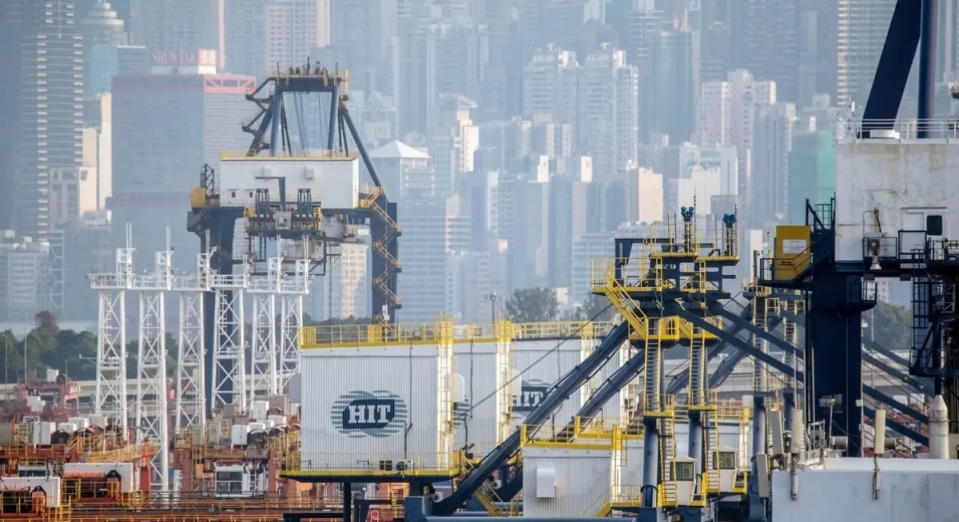OCBC and DBS maintain TPs for HPHT despite first-half overperformance, forecast earnings 'moderation' in the next half

OCBC and DBS have maintained their TPs for Hutchison Port Holdings Trust (HPHT) at 26 US cents and 37 US cents respectively.
OCBC Investment Research and DBS Group Research have maintained their “buy” calls and target prices (TP) for Hutchison Port Holdings Trust (HPHT) at 26 US cents (35.9 cents) and 37 US cents respectively.
In her report dated July 28, OCBC analyst Chu Peng writes that HPHT’s 1HFY2022 results were “broadly in line with expectations”, but looking into 2HFY2022, the outlook remains uncertain given global economic weakness and supply chain disruptions which could lead to a reduction in consumption.
She says that HPHT management has maintained its full-year distribution per unit (DPU) guidance of 14.5 to 15.5 HK cents (2.55 cents to 2.73 cents), which she believes is “achievable” but adds that she is keeping her full-year DPU estimate at 14.5 HK cents, on the lower end of management’s guidance.
A note from DBS Research on July 26 says that although HPHT reported a 1HFY2022 net profit of HK$716 million which made up 60% of DBS’s full-year forecast, its management is “more cautious” for the second half of the financial year.
Led by higher revenue per twenty-foot equivalent unit (TEU), HPHT performed “better than expected”, with its half year set of core results showing its revenue of HK$6.5 billion also standing at 54% of the bank’s full-year forecast.
While its 2HFY2022 earnings could moderate on “weaker outlook and cost pressures”, DBS expects that full-year earnings should “at least” meet its forecasts. HPHT’s interim dividends per unit (DPU) stands at 6.5 HK cents, the same as last year.
HPHT throughput volume was flat year-on-year (y-o-y), with its Kwai Tsing Port losing 7.4% throughput volume y-o-y and Yantian International Container Terminals (YICT) making up the loss with am increase of 6.7% y-o-y.
OCBC’s Chu says that given the impact of higher fuel and power costs, HPHT raised tariff by around 5% for YICT but did not do so for Kwai Tsing. According to her, HPHT management explained that most of the cargo handled at Kwai Tsing was for transshipment due to the closure of borders, with the lack of local cargo making Hong Kong a less attractive port to shipping lines.
Additionally, shipping lines have wider choices of ports to transship their cargos, so competition is more intense compared to export and import hubs, such as YICT, making it difficult to raise tariff rates for Kwai Tsing, the analyst explains.
“Management expects Kwai Tsing’s performance to remain challenging in 2H22 due to stringent Covid-19 restrictions which could impact local cargo volume. On the other hand, the throughput at YICT is likely to see a flattish to 5% growth,” Chu writes.
The DBS note also points out the HPHT’s balance sheet has improved thanks to more payment of debt than expected. Its total consolidated debt stood at HK$27.3 million as at June 30 compared to HK$29.0 million as at the end of last year.
“We estimate that its net-debt to ebitda could further fall, from an already low 2.1x at end FY2021, to below 2x by end FY2022. This will be an all-time low for the Trust and bodes well for sentiment in this current environment. Further, 86% of the Trust’s debt has a fixed interest rate, which should help to mitigate expected increases in the Fed Funds Rate in the next few years,” says DBS.
Chu’s potential catalysts for HPHT include an improved US-China trade relationship that could precipitate a stronger-than-expected pick up in global trade, while her investment risks remain the continued escalation in trade tensions and a slowdown in the global economy.
As at 12.11pm, shares in HPHT were trading down 2.08% at 24 US cents.
See Also:
Click here to stay updated with the Latest Business & Investment News in Singapore
Valuations for property developers remain attractive despite slow home sales in June
FCT remains 'resilient', but borrowing costs starting to rise: analysts
Get in-depth insights from our expert contributors, and dive into financial and economic trends